Practices of Linked Open Data in Archaeology and Their Realisation in Wikidata
Abstract
:1. Introduction
“To be successful, archaeology needs not only better policies for data curation, but also the harmonising of the processes of data creation and its deposition for archiving.” [1]
2. Understanding Linked Open Data (LOD)
“The Semantic Web is not designed just as a new data model—it is specifically appropriate to the linking of data of many different models. One of the great things it will allow is to add information relating different databases on the Web, to allow sophisticated operations to be performed across them”. [25]
- Resources (or things) being described should be named with URIs, a universal form of URLs.
- The URIs used, should be HTTP URIs, to enable looking up the URI names.
- Useful information should be provided using standards, such as RDF* (i.e., the entire family of RDF standards [26]) and SPARQL.
- Links to other URIs should be included.
2.1. Creating and Publishing LOD
LOD with Wikidata
2.2. Benefits and Drawbacks of LOD
3. LOD in Archaeology
4. Wikidata for Archaeology
4.1. Practical Approaches to Realising LOD in Wikidata
4.1.1. A Workflow from Legacy Data to Wikidata: Linked Open Samian Ware
4.1.2. Linked Open Ogham: Connecting Catalogues Using Wikidata
4.1.3. Bibliography of Bronze Age Aegean Seals
4.1.4. Source Attribution of a Finds Database in Wikidata
4.1.5. Iconography in Wikidata: Linked Open African Red Slip Ware
4.1.6. Wikidata as an Open Reference Collection for Citizen Science
4.2. Tools for Wikidata
4.3. Summarising the Role of Wikidata
5. Conclusions
“If one aim of preserving data is for others to be able to use it, we need to increase practitioners’ skills in accessing and using data. Broadening data literacy skills over the next decade will help us realize the full potential of archaeological data.” ([152] p. 82)
Author Contributions
Funding
Institutional Review Board Statement
Informed Consent Statement
Data Availability Statement
Conflicts of Interest
Abbreviations
| ADS | Archaeology Data Service |
| ARS | African Red Slip Ware |
| ARS3D | African Red Slip Ware digital project |
| CAA | Computer Applications and Quantitative Methods in Archaeology |
| CC0 | Creative Commons Licence 0 (Public Domain) |
| CC BY | Creative Commons Licence Author Attribution |
| CeraTyOnt | Ceramic Typologies Ontology |
| CIDOC | Comité International pour la Documentation |
| (Eng. International Committee for Documentation) | |
| CIDOC CRM | CIDOC Conceptual Reference Model |
| CIIC | Corpus Inscriptionum Insularum Celticarum |
| CISP | Celtic Inscribed Stones Project |
| CMS | Corpus der Minoischen und Mykenischen Siegel |
| (Eng. Corpus of Minoan andMycenaean Seals) | |
| DANTE | DAtendrehscheibe für Normdaten und TErminologien |
| (Eng. data hub for authority files and terminologies) | |
| DFG | Deutsche Forschungsgemeinschaft (Eng. German Research Foundation) |
| FAIR | Findable, Accessible, Interoperable, Re-usable |
| Getty AAT | Getty Art & Architecture Thesaurus |
| HTTP URI | Uniform Resource Identifier for an object on the World Wide Web |
| LD | Linked Data |
| LIDO | Lightweight Information Describing Objects |
| LOD | Linked Open Data |
| LOUD | Linked Open Usable Data |
| NFDI | Nationale Forschungsdateninfrastruktur |
| (Eng. national research data infrastructure) | |
| QID | Wikidata Q-Identifier |
| RDF | Reference Description Framework |
| RGZM | Römisch-Germanisches Zentralmuseum in Mainz |
| SPARQL | SPARQL Protocol And RDF Query Language |
| URI | Uniform Resource Identifier |
| URL | Uniform Resource Locator |
| W3C | World Wide Web Consortium |
References
- Richards, J.D.; Jakobsson, U.; Novák, D.; Štular, B.; Wright, H. Digital Archiving in Archaeology: The State of the Art. Introduction. Internet Archaeol. 2021, 58. [Google Scholar] [CrossRef]
- Bauer, B.; Ferus, A.; Gorraiz, J.; Gründhammer, V.; Gumpenberger, C.; Maly, N.; Mühlegger, J.M.; Preza, J.L.; Solís, B.S.; Schmidt, N.; et al. Forschende und Ihre Daten. Ergebnisse Einer Österreichweiten Befragung (PDF Full Report DE): Report 2015. Available online: https://phaidra.univie.ac.at/o:407513 (accessed on 1 June 2022).
- Heinrich, M.; Sieverling, A.; Schäfer, F.; Jahn, S.; Altertumswissenschaften, I.F.F.A. Stakeholderanalyse zu Forschungsdaten in den Altertumswissenschaften; IANUS—FDZ Archäologie & Altertumswissenschaften: 2015. Available online: https://www.ianus-fdz.de/projects/ap3-community/wiki/Stakeholderanalyse (accessed on 1 June 2022). [CrossRef]
- Schmidt, S.C.; Backhaus, H.; Keller, C.; Rokohl, L.; Thiery, F. Preliminary Report on the NFDI4Objects Survey. 2020. Available online: https://osf.io/zcexm/ (accessed on 27 January 2022).
- Geser, G.; Richards, J.D.; Massara, F.; Wright, H. Data Management Policies and Practices of Digital Archaeological Repositories. Internet Archaeol. 2022, 59, 1–52. [Google Scholar] [CrossRef]
- Marwick, B.; Birch, S.E.P. A Standard for the Scholarly Citation of Archaeological Data as an Incentive to Data Sharing. Adv. Archaeol. Pract. 2018, 6, 125–143. [Google Scholar] [CrossRef] [Green Version]
- Jakobsson, U.; Novák, D.; Richards, J.D.; Štular, B.; Wright, H. Digital Archiving in Archaeology: The State of the Art. Internet Archaeol. 2021, 58, 1–5. [Google Scholar]
- Berners-Lee, T.; Fischetti, M. Weaving the Web: The Original Design and Ultimate Destiny of the World Wide Web by Its Inventor. 1999. Available online: http://archive.org/details/isbn_9780062515872 (accessed on 14 April 2022).
- Berners-Lee, T. Linked Data—Design Issues. 2006. Available online: https://www.w3.org/DesignIssues/LinkedData.html (accessed on 7 January 2022).
- Vrandečić, D.; Krötzsch, M. Wikidata: A free collaborative knowledgebase. Commun. ACM 2014, 57, 78–85. [Google Scholar] [CrossRef]
- Isaksen, L. Archaeology and the Semantic Web. 2011. Available online: https://eprints.soton.ac.uk/206421/ (accessed on 12 April 2022).
- Geser, G. ARIADNE WP15 Study: Towards a Web of Archaeological Linked Open Data. 2016. Available online: http://legacy.ariadne-infrastructure.eu/wp-content/uploads/2019/01/ARIADNE_archaeological_LOD_study_10-2016-1.pdf (accessed on 21 February 2022).
- Blaney, J. Introduction to the Principles of Linked Open Data. Program. Hist. 2017, 6. [Google Scholar] [CrossRef]
- What Are Linked Data and Linked Open Data? 2022. Available online: https://www.ontotext.com/knowledgehub/fundamentals/linked-data-linked-open-data/ (accessed on 14 April 2022).
- Opendata.Swiss. Handbook.Opendata.Swiss: Linked Open Data. Available online: https://handbook.opendata.swiss/de/content/glossar/bibliothek/linked-open-data.html (accessed on 24 May 2022).
- Bizer, C.; Heath, T.; Berners-Lee, T. Linked Data—The Story So Far. Int. J. Semant. Web Inf. Syst. 2009, 5, 1–22. [Google Scholar] [CrossRef] [Green Version]
- Berners-Lee, T. Semantic Web Roadmap. 1998. Available online: https://www.w3.org/DesignIssues/Semantic.html (accessed on 14 April 2022).
- Berners-Lee, T.; Hendler, J.; Lassila, O. The Semantic Web. Sci. Am. 2001, 284, 34–43. [Google Scholar] [CrossRef]
- Gartner, R. Breaking the Silos. In Metadata; Springer International Publishing: Cham, Switzerland, 2016; pp. 87–96. [Google Scholar] [CrossRef]
- Wikipedia Contributors. Machine-Readable Data—Wikipedia, The Free Encyclopedia. 2021. Available online: https://en.wikipedia.org/w/index.php?title=Machine-readable_data&oldid=1057115179 (accessed on 14 April 2022).
- W3C. Semantic Web. 2015. Available online: https://www.w3.org/standards/semanticweb/ (accessed on 7 January 2022).
- Manola, F.; Miller, E.; McBride, B. W3C: RDF 1.1 Primer. 2014. Available online: http://www.w3.org/TR/2014/NOTE-rdf11-primer-20140624/ (accessed on 17 May 2022).
- Aranda, C.B.; Olivier Corby, S.D.; Feigenbaum, L.; Gearon, P.; Glimm, B.; Harris, S.; Hawke, S.; Herman, I.; Humfrey, N.; Michaelis, N.; et al. W3C: SPARQL 1.1 Overview. 2013. Available online: https://www.w3.org/TR/sparql11-overview/ (accessed on 14 April 2022).
- Wikipedia. Phaistos Disc. Page Version ID: 1081215059.2022. Available online: https://en.wikipedia.org/w/index.php?title=Phaistos_Disc&oldid=1081215059 (accessed on 14 April 2022).
- Berners-Lee, T. What a Semantic Can Represent. 1998. Available online: https://www.w3.org/DesignIssues/RDFnot.html (accessed on 14 April 2022).
- Wood, D.; Zaidman, M.; Ruth, L.; Hausenblas, M. Linked Data: Structured Data on the Web; Manning: Shelter Island, NY, USA, 2014; OCLC: ocn828182162. [Google Scholar]
- The Linked Open Data Cloud. 2020. Available online: https://lod-cloud.net/ (accessed on 27 May 2022).
- Bray, T.; Hollander, D.; Layman, A.; Tobin, R.; Thompson, H.S. W3C: Namespaces in XML 1.0 (Third Edition). 2009. Available online: http://www.w3.org/TR/2009/REC-xml-names-20091208/ (accessed on 14 April 2022).
- W3C. Ontologies. 2015. Available online: https://www.w3.org/standards/semanticweb/ontology (accessed on 14 April 2022).
- Harpring, P. Introduction to Controlled Vocabularies. 2010. Available online: https://www.getty.edu/research/publications/electronic_publications/intro_controlled_vocab/index.html (accessed on 20 April 2022).
- iDAI. Objects/Arachne. 2022. Available online: https://arachne.dainst.org/ (accessed on 19 April 2022).
- Institute for the Study of the Ancient World (NYU); Ancient World Mapping Center (UNC-CH). Pleiades. 2009. Available online: https://pleiades.stoa.org (accessed on 14 April 2022).
- Simon, R.; Isaksen, L.; Barker, E.; de Soto Cañamares, P. The Pleiades Gazetteer and the Pelagios Project. In Placing Names: Enriching and Integrating Gazetteers; OCLC: ocn933437838; Berman, M.L., Mostern, R., Southall, H., Eds.; The Spatial Humanities, Indiana University Press: Bloomington, IN, USA, 2016; pp. 97–109. [Google Scholar]
- Open Knowledge Foundation. Open Definition 2.1. 2015. Available online: http://opendefinition.org/od/2.1/en/ (accessed on 14 April 2022).
- Shafranovich, Y. RFC 4180. Common Format and MIME Type for Comma-Separated Values (CSV) Files. 2005. Available online: https://datatracker.ietf.org/doc/html/rfc4180 (accessed on 17 May 2022).
- Creative Commons. About CC Licenses. 2019. Available online: https://creativecommons.org/about/cclicenses/ (accessed on 14 April 2022).
- Siebes, R.; Coen, G.; Gregory, K.; Scharnhorst, A. Linked Open Data. 2019. Available online: https://librarycarpentry.org/Top-10-FAIR//2019/09/05/linked-open-data/ (accessed on 24 May 2022).
- Frosterus, M.; Hansson, D.; Dadvar, M.; Kyriazis, I.; Zapounidou, S.; Grant, G. Best Practices for Library Linked Open Data (LOD) Publication. Available online: https://libereurope.eu/wp-content/uploads/2021/02/LOD-Guidelines-FINAL-Feb-2021.pdf (accessed on 24 May 2022).
- Hyland, B.; Atemezing, G.; Villazón-Terrazas, B. Best Practices for Publishing Linked Data. 2014. Available online: http://www.w3.org/TR/2014/NOTE-ld-bp-20140109/ (accessed on 24 May 2022).
- Suominen, O.; Hyvönen, N. From MARC silos to Linked Data silos? O-Bib. Das Offene Bibl. 2017, 4, 1–13. [Google Scholar] [CrossRef]
- Rossenova, L. Examining Wikidata and Wikibase in the Context of Research Data Management Applications. 2022. Available online: https://blogs.tib.eu/wp/tib/2022/03/16/examining-wikidata-and-wikibase-in-the-context-of-research-data-management-applications/ (accessed on 12 April 2022).
- Internet Engineering Task Force (IETF). RFC 8259. The JavaScript Object Notation (JSON) Data Interchange Format; Bray, T., Ed.; Internet Engineering Task Force (IETF): Fremont, CA, USA, 2017; Available online: https://www.mediawiki.org/wiki/Wikibase/DataModel/Primer (accessed on 19 May 2022).
- DuCharme, B. The Wikidata Data Model and Your SPARQL Queries. 2017. Available online: http://www.snee.com/bobdc.blog/2017/04/the-wikidata-data-model-and-yo.html (accessed on 24 January 2022).
- MediaWiki. Wikibase/DataModel/Primer. 2022. Available online: https://www.mediawiki.org/wiki/Wikibase/DataModel/Primer (accessed on 19 April 2022).
- WikidataCommunity. Wikidata:Identifiers. 2021. Available online: https://www.wikidata.org/wiki/Wikidata:Identifiers (accessed on 24 January 2022).
- WikidataCommunity. List of Properties in Wikidata by Data Type: External Identifier. 2022. Available online: https://www.wikidata.org/w/index.php?title=Special:ListProperties/external-id&limit=50&offset=0 (accessed on 24 January 2022).
- Haak, L.L.; Fenner, M.; Paglione, L.; Pentz, E.; Ratner, H. ORCID: A system to uniquely identify researchers. Learn. Publ. 2012, 25, 259–264. [Google Scholar] [CrossRef] [Green Version]
- Paskin, N. Digital Object Identifier (DOI®) System. 2015. Available online: https://www.doi.org/overview/DOI_article_ELIS3.pdf (accessed on 25 January 2022).
- GeoNames. GeoNames. 2022. Available online: http://geonames.org/ (accessed on 25 January 2022).
- Neubert, J. Wikidata as a Linking Hub for Knowledge Organization Systems? Integrating an Authority Mapping into Wikidata and Learning Lessons for KOS Mappings. In Proceedings of the 17th European Networked Knowledge Organization Systems Workshop, Thessaloniki, Greece, 21 September 2017; pp. 14–25. [Google Scholar]
- Erxleben, F.; Günther, M.; Krötzsch, M.; Mendez, J.; Vrandečić, D. Introducing Wikidata to the Linked Data Web. In The Semantic Web—ISWC 2014; Mika, P., Tudorache, T., Bernstein, A., Welty, C., Knoblock, C., Vrandečić, D., Groth, P., Noy, N., Janowicz, K., Goble, C., Eds.; Springer International Publishing: Cham, Switzerland, 2014; Volume 8796, pp. 50–65. [Google Scholar] [CrossRef]
- The Linked Open Data Cloud: Wikidata. Available online: https://lod-cloud.net/dataset/wikidata (accessed on 27 May 2022).
- Meta. LinkedOpenData/Strategy2021—Meta, Discussion about Wikimedia Projects. 2022. Available online: https://meta.wikimedia.org/w/index.php?title=LinkedOpenData/Strategy2021&oldid=23106873 (accessed on 27 May 2022).
- Wikidata:Data Access. 2022. Available online: https://www.wikidata.org/w/index.php?title=Wikidata:Data_access&oldid=1637691714 (accessed on 28 May 2022).
- Binding, C.; May, K.; Souza, R.; Tudhope, D.; Vlachidis, A. Semantic Technologies for Archaeology Resources: Results from the STAR Project: Computer Applications and Quantitative Methods in Archaeology (CAA2010), Granada, April 2010. In Proceedings of the 38th Annual Conference on Computer Applications and Quantitative Methods in Archaeology, Granada, Spain, 6–9 April 2013; BAR Publishing: Oxford, UK, 2013; pp. 555–561. [Google Scholar]
- Gerth, P.; Sieverling, A.; Trognitz, M. Data Curation: How and Why. A Showcase with Re-use Scenarios. Stud. Digit. Herit. 2017, 1, 182–193. [Google Scholar] [CrossRef] [Green Version]
- Evans, T. Linking It All Together. Available online: http://www.archaide.eu/blog/-/blogs/38396326 (accessed on 24 May 2022).
- LeFebvre, M.J.; Brenskelle, L.; Wieczorek, J.; Kansa, S.W.; Kansa, E.C.; Wallis, N.J.; King, J.N.; Emery, K.F.; Guralnick, R. ZooArchNet: Connecting zooarchaeological specimens to the biodiversity and archaeology data networks. PLoS ONE 2019, 14, e0215369. [Google Scholar] [CrossRef] [PubMed]
- Network (CHIN)Linked Open Data—Benefits and Challenges. Available online: https://chin-rcip.github.io/collections-model/en/resources/current/lod-benefits-challenges (accessed on 24 May 2022).
- Wenige, L.; Ruhland, J. Retrieval by recommendation: Using LOD technologies to improve digital library search. Int. J. Digit. Libr. 2018, 19, 253–269. [Google Scholar] [CrossRef]
- Debole, F.; Meghini, C.; Geser, G.; Tudhope, D. D15.2: Report on the ARIADNE Linked Data Cloud. 2017. Available online: http://legacy.ariadne-infrastructure.eu/wp-content/uploads/2019/01/D15.2_Report-on-the-ARIADNE_Linked_Data_Cloud_Final.pdf (accessed on 1 June 2022).
- Hofmann, K.; Grunwald, S.; Lang, F.; Peter, U.; Rösler, K.; Rokohl, L.; Schreiber, S.; Tolle, K.; Wigg-Wolf, D. Ding-Editionen. Vom archäologischen (Be-)Fund übers Corpus ins Netz. 2019. Available online: https://publications.dainst.org/journals/efb/article/download/2236/6674/ (accessed on 30 May 2022).
- Abhayaratna, J.; van den Brink, L.; Car, N.; Atkinson, R.; Homburg, T.; Knibbe, F.; McGlinn, K.; Wagner, A.; Bonduel, M.; Rasmussen, M.H.; et al. OGC Benefits of Representing Spatial Data Using Semantic and Graph Technologies. Available online: http://www.opengis.net/doc/wp/using-semantic-graph (accessed on 24 May 2022).
- Nayak, A.; Božić, B.; Longo, L. (Linked) Data Quality Assessment: An Ontological Approach. 2021. Available online: http://ceur-ws.org/Vol-2956/paper17.pdf (accessed on 30 May 2022).
- Thiery, F.; Homburg, T.; Schmidt, S.C.; Voß, J.; Trognitz, M. SPARQLing Geodesy for Cultural Heritage—New Opportunities for Publishing and Analysing Volunteered Linked (geo-)data. In Proceedings of the FIG e-Working Week 2021—Smart Surveyors for Land and Water Management—Challenges in a New Reality Virtually in the Netherlands, Virtual, 21–25 June 2021; FIG: Kopenhagen, Denmark, 2021. [Google Scholar] [CrossRef]
- Nomisma. Nomisma.org. 2022. Available online: http://nomisma.org (accessed on 19 April 2022).
- Huvila, I. Being FAIR When Archaeological Information Is MEAN: Miscellaneous, Exceptional, Arbitrary, Nonconformist. 2017. Available online: https://www.istohuvila.fi/files/IstoHuvilaCDH2017-handout.pdf (accessed on 31 May 2022).
- Rula, A.; Maurino, A.; Batini, C. Data Quality Issues in Linked Open Data. In Data and Information Quality; Springer International Publishing: Cham, Switzerland, 2016; pp. 87–112. [Google Scholar] [CrossRef]
- Gruber, E. Numishare: On Stable URIs at the British Museum. Available online: http://numishare.blogspot.com/2018/02/on-stable-uris-at-british-museum.html (accessed on 31 May 2022).
- Marcus Smith. Is the British Museum’s Endpoint Working? (@bm_lod_status)/Twitter. Available online: https://web.archive.org/web/20220211180616/https://twitter.com/bm_lod_status/status/1492197022413336584 (accessed on 31 May 2022).
- Thiery, F.; Mees, A.; Arera-Rütenik, T. TRAIL4.2: Implementing Mapping Processes for Vocabularies Related to Site and Object Protection; Zenodo: Geneva, Switzerland, 2021. [Google Scholar] [CrossRef]
- SPARQL Query Service/WDQS Backend Update/Blazegraph Failure Playbook. 2022. Available online: https://www.wikidata.org/w/index.php?title=Wikidata:SPARQL_query_service/WDQS_backend_update/Blazegraph_failure_playbook&oldid=1618872307 (accessed on 1 June 2022).
- Homburg, T.; Klammt, A.; Mara, H.; Schmid, C.; Schmidt, S.C.; Thiery, F.; Trognitz, M. Recommendations for the review of archaeological research software. Archäologische Inform. 2020, 43, 357–370. [Google Scholar] [CrossRef]
- iDAI World. 2022. Available online: https://idai.world/ (accessed on 19 April 2022).
- Archaeology Data Service. 2022. Available online: https://archaeologydataservice.ac.uk/ (accessed on 19 April 2022).
- re3data.org. Archaeology Data Service. 2012. Available online: https://www.re3data.org/repository/r3d100000006 (accessed on 19 April 2022). [CrossRef]
- Fernández González, J.M.; Polo Marques, A.; Cerrillo Cuenca, E. Bases for the Creation of Ontology in the Context of Archaeology. In The World Is in Your Eyes. CAA2005. Computer Applications and Quantitative Methods in Archaeology. Proceedings of the 33rd Conference, Tomar, March 2005; CAA Portugal: Tomar, Portugal, 2007; pp. 285–290. Available online: https://proceedings.caaconference.org/paper/42_fernandez_et_al_caa_2005/ (accessed on 19 April 2022).
- Isaksen, L.; Martinez, K.; Gibbins, N.; Earl, G.; Keay, S. Linking Archaeological Data. In Making History Interactive. Computer Applications and Quantitative Methods in Archaeology (CAA). Proceedings of the 37th International Conference Williamsburg, Virginia, United States of America, March 22–26 2009; Archaeopress: Oxford, UK, 2010; pp. 130–136. Available online: https://proceedings.caaconference.org/paper/18_isaksen_et_al_caa2009/ (accessed on 19 April 2022).
- May, K.; Binding, C.; Tudhope, D.; Jeffrey, S. Semantic Technologies Enhancing Links and Linked Data for Archaeological Resources. In Revive the Past. Computer Applications and Quantitative Methods in Archaeology (CAA). Proceedings of the 39th International Conference, Beijing, April 12-16 April 2011; Pallas Publications: Amsterdam, The Netherlands, 2012; pp. 261–272. Available online: https://proceedings.caaconference.org/paper/29_may_et_al_caa2011/ (accessed on 19 April 2022).
- Dentamaro, F.; De Luca, P.G.; Genco, L.; Perrino, G.; Cannito, C.; Stufano, M.A.; Sibilano, M.G. A CIDOC CRM-Based Ontology System. In Digital Discovery. Exploring New Frontiers in Human Heritage. CAA2006. Computer Applications and Quantitative Methods in Archaeology. Proceedings of the 34th Conference, Fargo, United States, April 2006; Archaeolingua: Budapest, Hungary, 2007; pp. 437–444. Available online: https://proceedings.caaconference.org/paper/cd45_dentamaro_et_al_caa2006/ (accessed on 19 April 2022).
- Cripps, P.; May, K. To OO or not to OO? Revelations from Ontological Modelling of an Archaeological Information System. In Beyond the Artifact. Digital Interpretation of the Past. Proceedings of CAA2004, Prato 13–17 April 2004; Archaeolingua: Budapest, Hungary, 2010; pp. 59–63. Available online: https://proceedings.caaconference.org/paper/08_cripps_may_caa_2004/ (accessed on 19 April 2022).
- Gonzalez-Perez, C.; Parcerero-Oubiña, C. A Conceptual Model for Cultural Heritage Definition and Motivation. In CAA2011—Revive the Past, Proceedings of the 39th Conference in Computer Applications and Quantitative Methods in Archaeology, Beijing, China, 12–16 April 2011; Mingquan, Z., Romanowska, I., Wu, Z., Xu, P., Verhagen, P., Eds.; Pallas Publications: Leiden, The Netherlands, 2012; pp. 234–244. [Google Scholar]
- LIDO Overview. 2022. Available online: https://cidoc.mini.icom.museum/working-groups/lido/lido-overview/ (accessed on 20 April 2022).
- CIDOC. CIDOC CRM. 2022. Available online: https://www.cidoc-crm.org (accessed on 14 April 2022).
- The Getty Research Institute. Art & Architecture Thesaurus. 2017. Available online: https://www.getty.edu/research/tools/vocabularies/aat/ (accessed on 14 April 2022).
- FISH. Terminology (FISH—Forum on Information Standards in Heritage). 2022. Available online: http://www.heritage-standards.org.uk/terminology/ (accessed on 14 April 2022).
- PeriodO. PeriodO—Periods, Organized. 2022. Available online: https://perio.do/en/ (accessed on 19 April 2022).
- Golden, P.; Shaw, R. Nanopublication beyond the sciences: The PeriodO period gazetteer. PeerJ Comput. Sci. 2016, 2, e44. [Google Scholar] [CrossRef] [Green Version]
- Gruber, E.; Pett, D.; Tolle, K.; Heath, S.; Wigg-Wolf, D.; Meadows, A. Semantic Web Technologies Applied to Numismatic Collections. In Archaeology in the Digital Era, Proceedings of the 40th Annual Conference of Computer Applications and Quantitative Methods in Archaeology (CAA), Southampton, UK, 26–29 March 2012; Earl, G., Sly, T., Wheatley, D., Romanowska, I., Papadopoulos, C., Murrieta-Flores, P., Chrysanthi, A., Eds.; Amsterdam University Press: Amsterdam, The Netherlands, 2012; Volume II, pp. 264–274. [Google Scholar] [CrossRef]
- Pelagios—The Digital Classicist Wiki. 2022. Available online: https://wiki.digitalclassicist.org/Pelagios (accessed on 19 April 2022).
- Tolle, K.; Wigg-Wolf, D.; Gruber, E. An Ontology for a Numismatic Island with Bridges to Others. 2018. In Oceans of Data. Proceedings of the 44rd Annual Conference on Computer Applications and Quantitative Methods in Archaeology; Archaeopress: Oxford, UK, 2018; pp. 103–108. Available online: https://www.archaeopress.com/Archaeopress/download/9781784917302 (accessed on 19 April 2022).
- Tolle, K.; Wigg-Wolf, D. Improving Data Quality by Rules: A Numismatic Example. In CAA: Digital Archaeologies, Material Worlds (Past and Present). Proceedings of the 2017 CAA Annual Meeting, New York, NY, USA, 14–16 March 2017; Universität Tübingen: Tübingen, Germany, 2020; pp. 193–201. [Google Scholar] [CrossRef]
- Thiery, F. Linking Potter, Pots And Places: A LOD Approach To Samian Ware. In Proceedings of the CAA 2014, Paris, France, 22–25 April 2014. [Google Scholar] [CrossRef]
- Gruber, E.; Gondek, R.; Smith, T.J. Kerameikos.org: Linked Open Data for Greek Pottery. In Proceedings of the CAA 2019: Poster Session, Krakow, Poland, 23–27 April 2019; Zenodo: Geneva, Switzerland, 2019. [Google Scholar] [CrossRef]
- Cuy, S.; Schmidle, W.; Thiery, F.; Kallas, N. Linking periods: Modeling and utilizing spatio-temporal concepts in the ChronOntology project. In Proceedings of the 44th Conference on Computer Applications and Quantitative Methods in Archaeology, Oslo, Norway, 30 March–3 April 2016; Zenodo: Oslo, Norway, 2016. (forthcoming). [Google Scholar]
- Wilkinson, M.D.; Dumontier, M.; Aalbersberg, I.J.; Appleton, G.; Axton, M.; Baak, A.; Blomberg, N.; Boiten, J.W.; da Silva Santos, L.B.; Bourne, P.E.; et al. The FAIR Guiding Principles for scientific data management and stewardship. Sci. Data 2016, 3, 160018. [Google Scholar] [CrossRef] [Green Version]
- Sanderson, R. LOUD: Linked Open Usable Data. 2019. Available online: https://linked.art/loud/ (accessed on 7 January 2022).
- Discover inspiring European cultural heritage|Europeana. 2022. Available online: https://www.europeana.eu/en (accessed on 19 April 2022).
- Welcome—Ariadne Portal. 2022. Available online: https://portal.ariadne-infrastructure.eu/ (accessed on 19 April 2022).
- Digital Index of North American Archaeology (DINAA)|Heritage Bytes. Available online: http://ux.opencontext.org/archaeology-site-data/ (accessed on 19 April 2022).
- Kansa, E.C.; Kansa, S.W.; Wells, J.J.; Yerka, S.J.; Myers, K.N.; DeMuth, R.C.; Bissett, T.G.; Anderson, D.G. The Digital Index of North American Archaeology: Networking government data to navigate an uncertain future for the past. Antiquity 2018, 92, 490–506. [Google Scholar] [CrossRef] [Green Version]
- Jeffrey, S.; Xia, L.; Richards, J.D.; Bateman, J.; Kintigh, K.; Pierce-McManamon, F.; Brin, A. The Transatlantic Archaeology Gateway: Bridging the Digital Ocean. In CAA2011—Revive the Past, Proceedings of the 39th Conference in Computer Applications and Quantitative Methods in Archaeology, Beijing, China, 12–16 April 2011; Mingquan, Z., Romanowska, I., Wu, Z., Xu, P., Verhagen, P., Eds.; Pallas Publications: Leiden, The Netherlands, 2012; pp. 198–208. [Google Scholar]
- May, K.; Binding, C.; Tudhope, D. Barriers and opportunities for Linked Open Data use in archaeology and cultural heritage. Archäologische Inform. 2015, 38, 173–184. [Google Scholar] [CrossRef]
- Bibby, D.; Bruhn, K.C.; Busch, A.; Dührkohp, F.; Himmelmann, U.; Höke, B.; Keller, C.; Lang, M.; Mees, A.; Metz, S.E.; et al. Digitales Forschungsdatenmanagement in der Archäologie und die Initiative NFDI4Objects. BLiCKpunkt Archäologie 2021, 2021, 150–164. [Google Scholar] [CrossRef]
- Thiery, F.; Mees, A.; Wienand, J.; Börner, S. TRAIL2.5: A workflow for enhancing iconography authority data in the Wikimedia Universe. In NFDI4Objects TRAILs; Zenodo: Geneva, Switzerland, 2021. [Google Scholar] [CrossRef]
- Mees, A.W.; Thiery, F.; Weisser, B. Digitale Vernetzung von Sammlungsdaten. Squirrel Papers 2021, 3, 1. [Google Scholar] [CrossRef]
- Samian Research Community. Samian Research. 2022. Available online: https://www.rgzm.de/samian (accessed on 19 April 2022).
- Hartley, B.R.; Dickinson, B.M. Names on Terra Sigillata: An Index of Makers’ Stamps & Signatures on Gallo-Roman Terra Sigillata (Samian Ware); Number 102 in Bulletin of the Institute of Classical Studies; Institute of Classical Studies, University of London: London, UK, 2008. [Google Scholar]
- Thiery, F.; Mees, A.; Gottwald, D. Linked Open Samian Ware—Unveiling the hidden Data Dragons and uncovering temporal vagueness with the help of Little Minions. In Proceedings of the Joint Chapter Meeting 2020 of Computer Applications and Quantitative Methods in Archaeology by the CAA chapters CAA-NL-FL and CAA-DE (JCM2020), Deventer, The Netherlands, 3–4 December 2020; Zenodo: Geneva, Switzerland, 2020. [Google Scholar] [CrossRef]
- Thiery, F. Semantic Web und Linked Data: Generierung von Interoperabilität in Archäologischen Fachdaten am Beispiel Römischer Töpferstempel. Master’s Thesis, Fachhochschule Mainz, Mainz, Germany, 2013. [Google Scholar] [CrossRef]
- Thiery, F.; Mees, A.W.; Gottwald, D. Linked Open Samian Ware: External Linking. 2021. Available online: https://rgzm.github.io/samian-lod/linking/ (accessed on 7 April 2022).
- Thiery, F.; Rokohl, L. Linked Open African Red Slip Ware. Squirrel Papers 2021, 3, 1. [Google Scholar] [CrossRef]
- Thiery, F.; Mees, A.; Gottwald, D. Linked Open Samian Ware; Zenodo: Geneva, Switzerland, 2020. [Google Scholar] [CrossRef]
- Quick Statements. 2022. Available online: https://quickstatements.toolforge.org/#/ (accessed on 19 April 2022).
- Online, V.P. DFD Using Yourdon and DeMarco Notation. 2022. Available online: https://online.visual-paradigm.com/knowledge/software-design/dfd-using-yourdon-and-demarco (accessed on 1 June 2022).
- Thiery, F.; Homburg, T. Linked Pipes @ Linked Pasts 7: Introduction; Zenodo: Geneva, Switzerland, 2021. [Google Scholar] [CrossRef]
- Thiery, F.; Homburg, T.; Trognitz, M. Linked Pipe: Linked Open Samian Ware; Zenodo: Geneva, Switzerland, 2021. [Google Scholar] [CrossRef]
- Cradle. 2022. Available online: https://cradle.toolforge.org/ (accessed on 19 April 2022).
- Trognitz, M.; Thiery, F. Wikidata—A SPARQL(ing) Unicorn? Zenodo: Geneva, Switzerland, 2019. [Google Scholar] [CrossRef]
- Thiery, F.; Schmidt, S.C.; Homburg, T.; Trognitz, M. The SPARQL Unicorn: An introduction; Zenodo: Geneva, Switzerland, 2020. [Google Scholar] [CrossRef]
- Homburg, T.; Thiery, F. SPARQLing Unicorn QGIS Plugin; Zenodo: Geneva, Switzerland, 2021. [Google Scholar] [CrossRef]
- Bogdani, J.; Montalbano, R.; Rosati, P. ArcheoFOSS XIV 2020: Open Software, Hardware, Processes, Data and Formats in Archaeological Research; Archaeopress Publishing Ltd: Oxford, UK, 2021; OCLC: 1274200091. [Google Scholar]
- Schmidt, S.C.; Thiery, F. SPARQLing Ogham Stones: New Options for Analyzing Analog Editions by Digitization in Wikidata. CEUR Workshop Proc. 2022, 3110, 211–244. [Google Scholar] [CrossRef]
- Thiery, F. My Little Linked Open Data Ogham Minion: Visualising Graph Data Connections Using SPARQL Endpoints, Talk at CAA 2021, Limassol, Cyprus; Zenodo: Geneva, Switzerland, 2021. [Google Scholar] [CrossRef]
- Macalister, R.A.S. Corpus inscriptionum insularum Celticarum; Stationery Office: Dublin, Irland, 1945; Volume I, QID: Q70256237. [Google Scholar]
- MacManus, D. A Guide to Ogam; Number 4 in Maynooth monographs; An Sagart: Maynooth, Ireland, 1997; OCLC: 248434889; QID: Q70310399. [Google Scholar]
- O’Sullivan, A.; Sheehan, J. The Iveragh Peninsula. An Archaeological Survey of South Kerry; Cork University Press: Cork, Ireland, 1996. [Google Scholar]
- Younger, J.G. A Bibliography for Aegean glyptic in the Bronze Age; Vol. Beiheft 4, Corpus der Minoischen und Mykenischen Siegel; Gebr. Mann: Berlin, Germany, 1991. [Google Scholar] [CrossRef]
- Hayes, J.W. Late Roman Pottery; British School at Rome: London, UK, 1972; QID: Q50262763. [Google Scholar]
- Thiery, F.; Raddatz, L.; Boochs, F. Close to the Original-Erfassung archäologischer Objekte und ihre webbasierte semantisch modellierte Bereitstellung zur fachwissenschaftlichen Analyse. In Photogrammetrie—Laserscanning—Optische 3D-Messtechnik: Beiträge der Oldenburger 3D-Tage 2022 [In Print]; Wichmann: Berlin, Germany, 2022; OCLC: 1102430437. [Google Scholar]
- Thiery, F.; Rokohl, L. African Red Slip Ware digital (ARS3D)—The Portal. Squirrel Papers 2021, 3, 1. [Google Scholar] [CrossRef]
- Kabashi, A. ICONCLASS—Classification System for Art and Iconography. 2019. Available online: https://urn.nsk.hr/urn:nbn:hr:131:711297 (accessed on 19 April 2022).
- Zu Löwenstein, S. Mythologische Darstellungen auf Gebrauchsgegenständen der Spätantike: Die Appliken-und Reliefverzierte Sigillata C3/C4; Number 48 in Kölner Jahrbuch; Gebr. Mann: Berlin, Germany, 2015; pp. 397–823. [Google Scholar]
- Armstrong, M. A Thesaurus of Applied Motives on African Red Slip Ware. Ph.D. Thesis, New York University, New York, NY, USA, 1993. OCLC: 60852088; QID: Q109525251. [Google Scholar]
- Anselmino, L.; Carandini, A.; Pavolini, C.; Sagui, L.; Tortorella, S.; Tortorici, E. Atlante Delle Forme Ceramiche: Ceramica Fina Romana nel Bacino Mediterraneo; Vol. 1, Enciclopedia Dell’arte Antica Classica e Orientale; Istituto della Enciclopedia Italiana: Roma, Italy, 1981; OCLC: 1124005431; QID: Q109525400. [Google Scholar]
- Thiery, F. African Red Slip Ware—Additional Iconography Catalogue. Squirrel Papers 2022, 4, 1. [Google Scholar] [CrossRef]
- Wikidata Query Service. 2022. Available online: https://query.wikidata.org/ (accessed on 19 April 2022).
- Wikidata: Linked Open Data Workflow. 2021. Available online: https://www.wikidata.org/w/index.php?title=Wikidata:Linked_open_data_workflow&oldid=1493989706 (accessed on 28 May 2022).
- Manske, M. Cradle. 2022. Available online: https://github.com/magnusmanske/cradle (accessed on 19 April 2022).
- Wikidata Query Service/User Manual—MediaWiki. 2022. Available online: https://www.mediawiki.org/wiki/Wikidata_Query_Service/User_Manual (accessed on 19 April 2022).
- Wikidata:SPARQL Query Service/Wikidata Query Help—Wikidata. 2022. Available online: https://www.wikidata.org/wiki/Wikidata:SPARQL_query_service/Wikidata_Query_Help (accessed on 19 April 2022).
- Wikidata Query Builder. 2022. Available online: https://query.wikidata.org/querybuilder/ (accessed on 19 April 2022).
- Thiery, F.; Homburg, T. SPARQLing Unicorn QGIS Plugin. 2022. Available online: https://github.com/sparqlunicorn/sparqlunicornGoesGIS (accessed on 19 April 2022).
- Help: QuickStatements—Wikidata. 2022. Available online: https://www.wikidata.org/wiki/Help:QuickStatements (accessed on 19 April 2022).
- Open Refine. 2022. Available online: https://openrefine.org/ (accessed on 19 April 2022).
- Wikidata: Tools/OpenRefine—Wikidata. 2022. Available online: https://www.wikidata.org/wiki/Wikidata:Tools/OpenRefine (accessed on 19 April 2022).
- Nielsen, F.Å.; Mietchen, D.; Willighagen, E. Scholia and scientometrics with Wikidata. In Proceedings of the 1st International Workshop on Scientometrics and 1st International Workshop on Enabling Decentralised Scholarly Communication (SciEDSC), Portorož, Slovenia, 28 May–1 June 2017; Springer: Cham, Switzerland Aachen; 3; urn:nbn:de:0074-1878-8. [Google Scholar]
- Robinson, M. Illuminating Hopewell Legacy Data: A Case Study of Mound 23 at Hopewell Mound Group. 2016. Available online: https://digitalcommons.unl.edu/anthrotheses/46 (accessed on 14 April 2022).
- Laneri, N.; Brancato, R.; Figuera, M.; Cristofaro, S.; Spampinato, D.; Asmundo, N.; Santamari, D.F. Towards an ontology of the Museum of Archaeology of the University of Catania: From the digitization of the legacy data to the Semantic Web. ArcheoFOSS XIV 2020: Open Software, Hardware, Processes, Data and Formats in Archaeological Research. In Proceedings of the 14th International Conference, Online, 15–17 October 2020; Archaeopress: Oxford, UK, 2021; pp. 128–137. [Google Scholar]
- Jones-Cervantes, S.A.; Blinman, E.; Tauxe, L.; Cox, J.R.; Lengyel, S.; Sternberg, R.; Eighmy, J.; Wolfman, D.; DuBois, R. MagIC as a FAIR repository for America’s directional archaeomagnetic legacy data. Earth Space Sci. Open Arch. ESSOAr 2021, 25. [Google Scholar] [CrossRef]
- Opitz, R. Publishing Archaeological Excavations at the Digital Turn. J. Field Archaeol. 2018, 43, S68–S82. [Google Scholar] [CrossRef] [Green Version]
- Kansa, E.; Kansa, S.W. Digital Data and Data Literacy in Archaeology Now and in the New Decade. Adv. Archaeol. Pract. 2020, 9, 81–85. [Google Scholar] [CrossRef]
- Anzt, H.; Bach, F.; Druskat, S.; Löffler, F.; Loewe, A.; Renard, B.Y.; Seemann, G.; Struck, A.; Achhammer, E.; Aggarwal, P.; et al. An environment for sustainable research software in Germany and beyond: Current state, open challenges, and call for action. F1000Research 2021, 9, 295. [Google Scholar] [CrossRef]
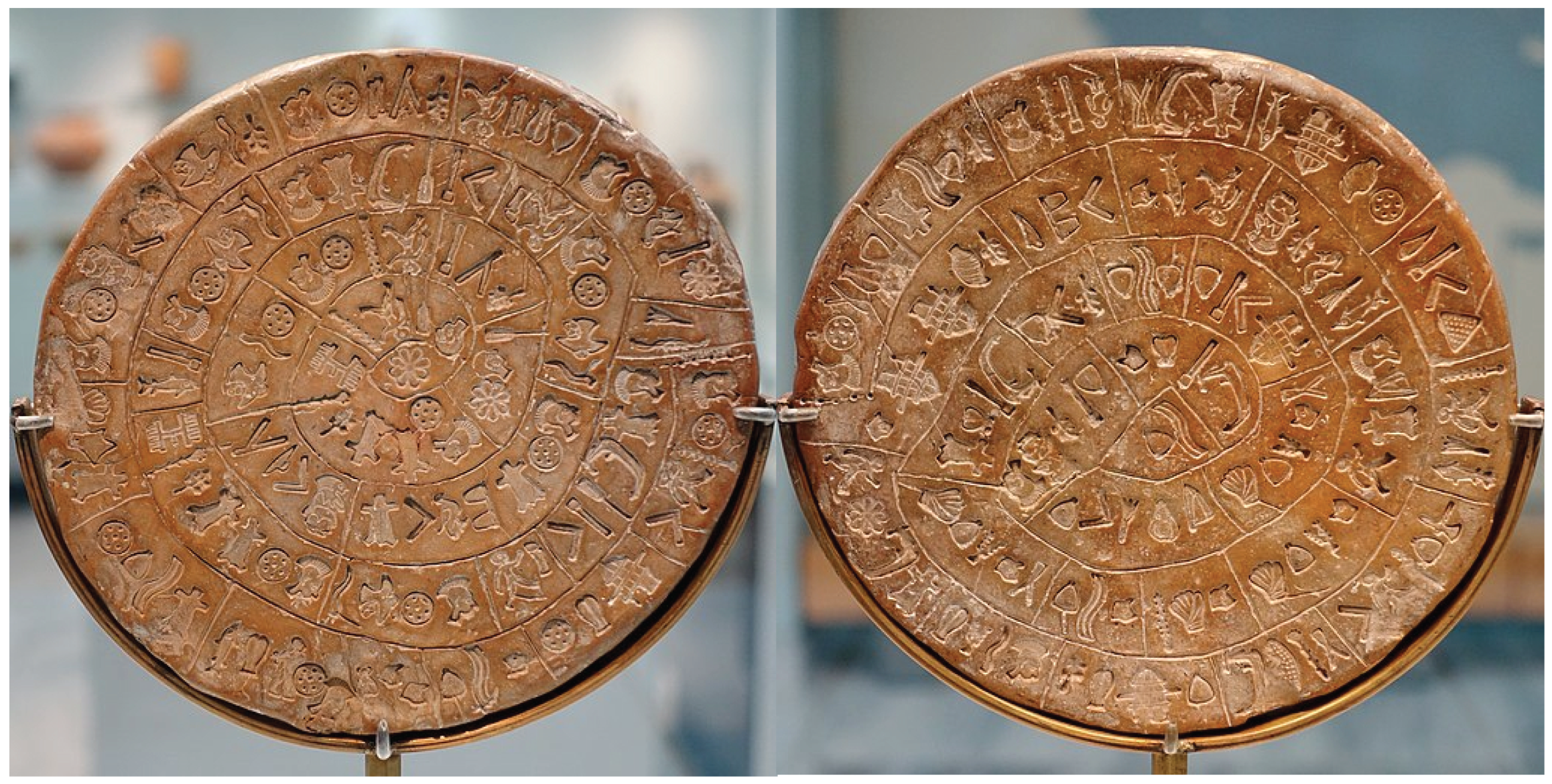



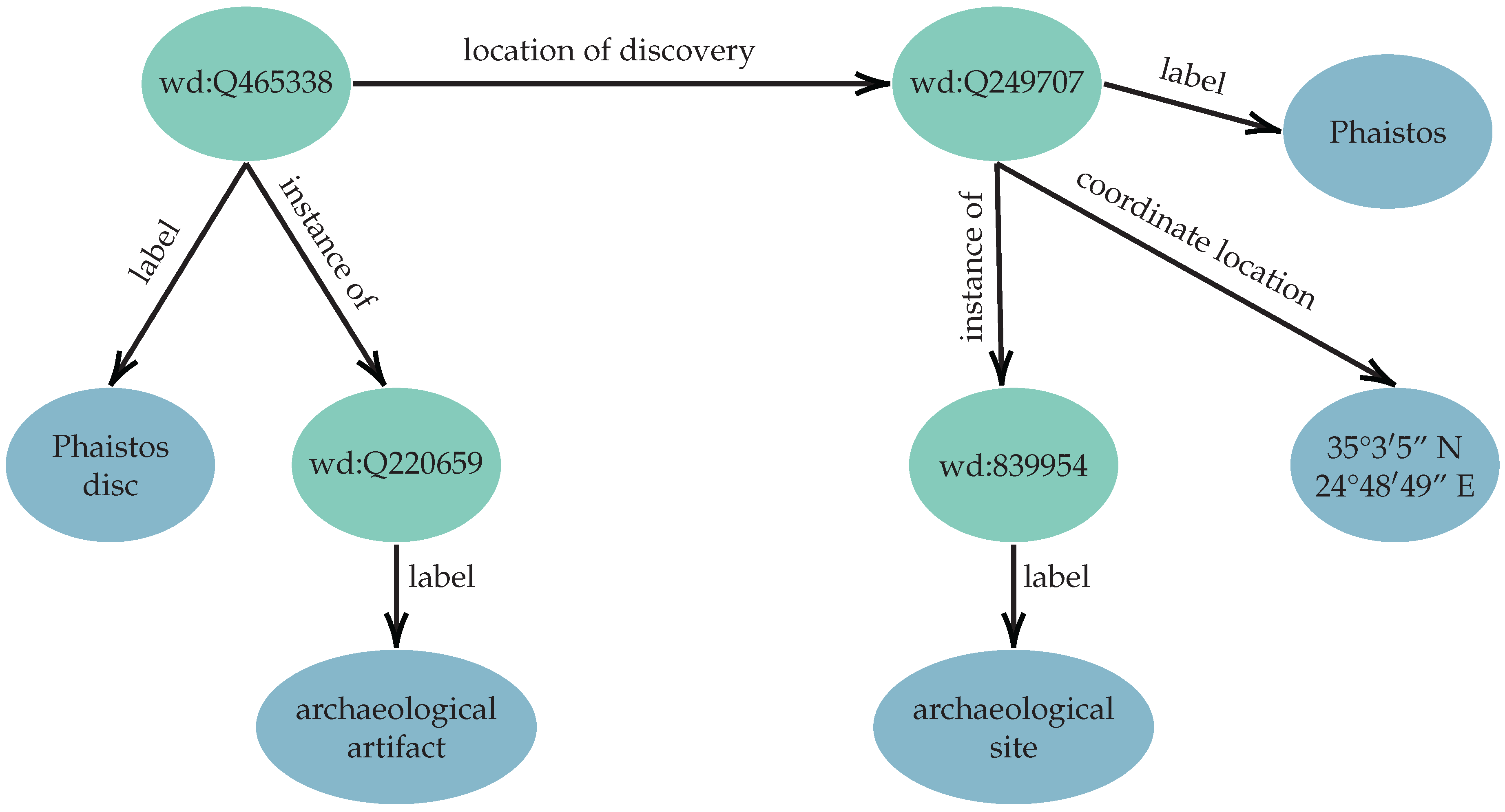
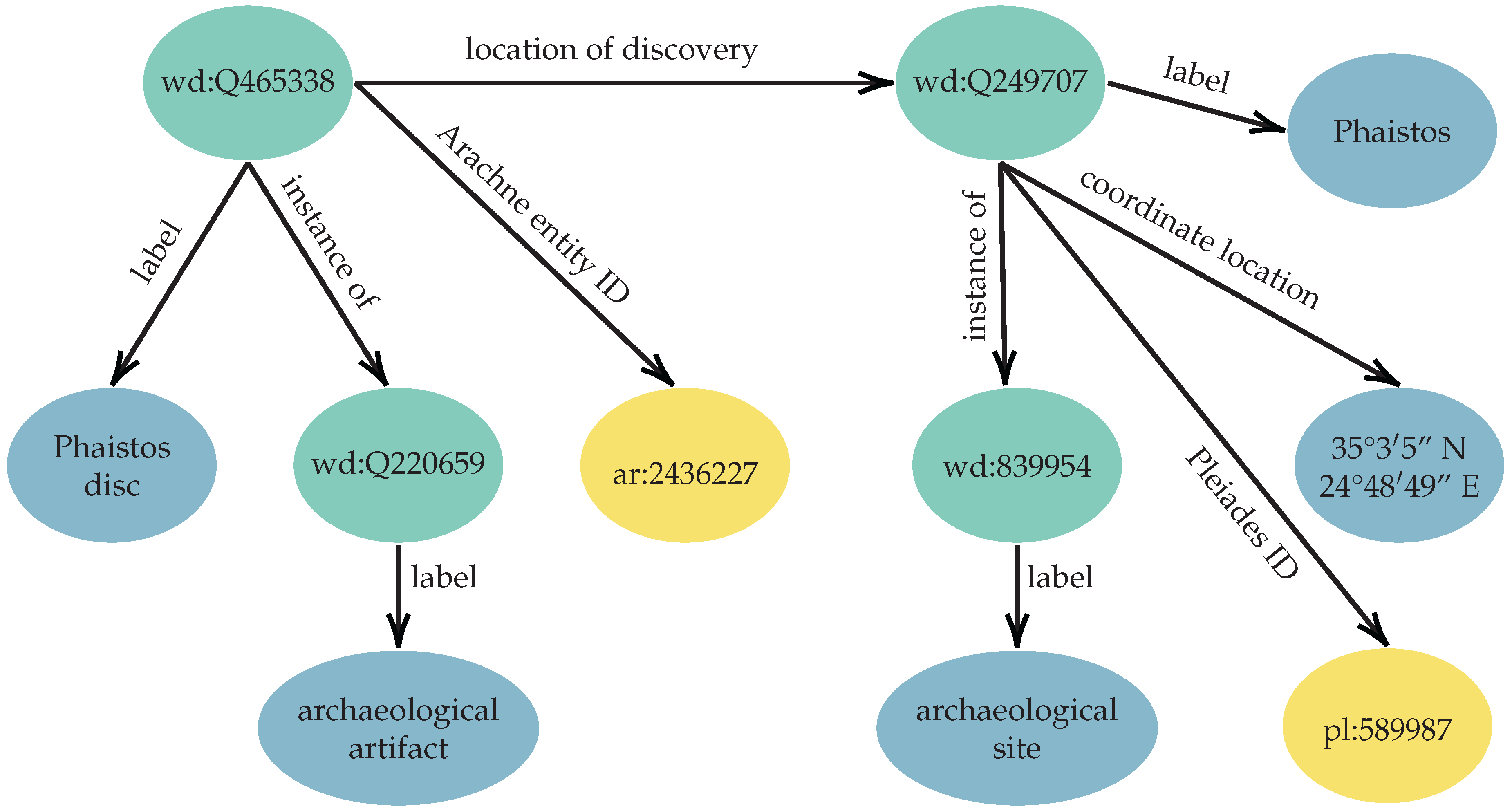

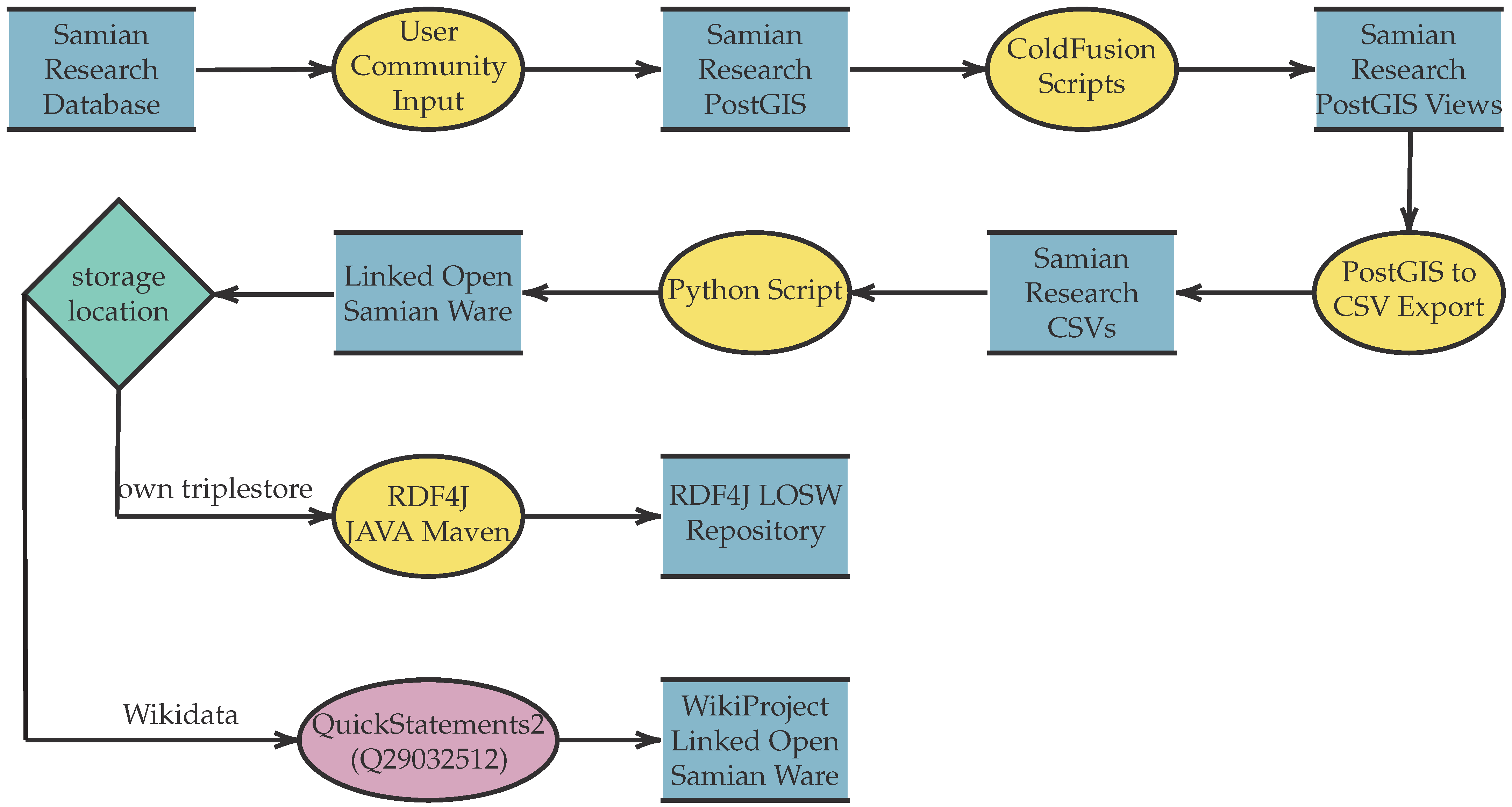
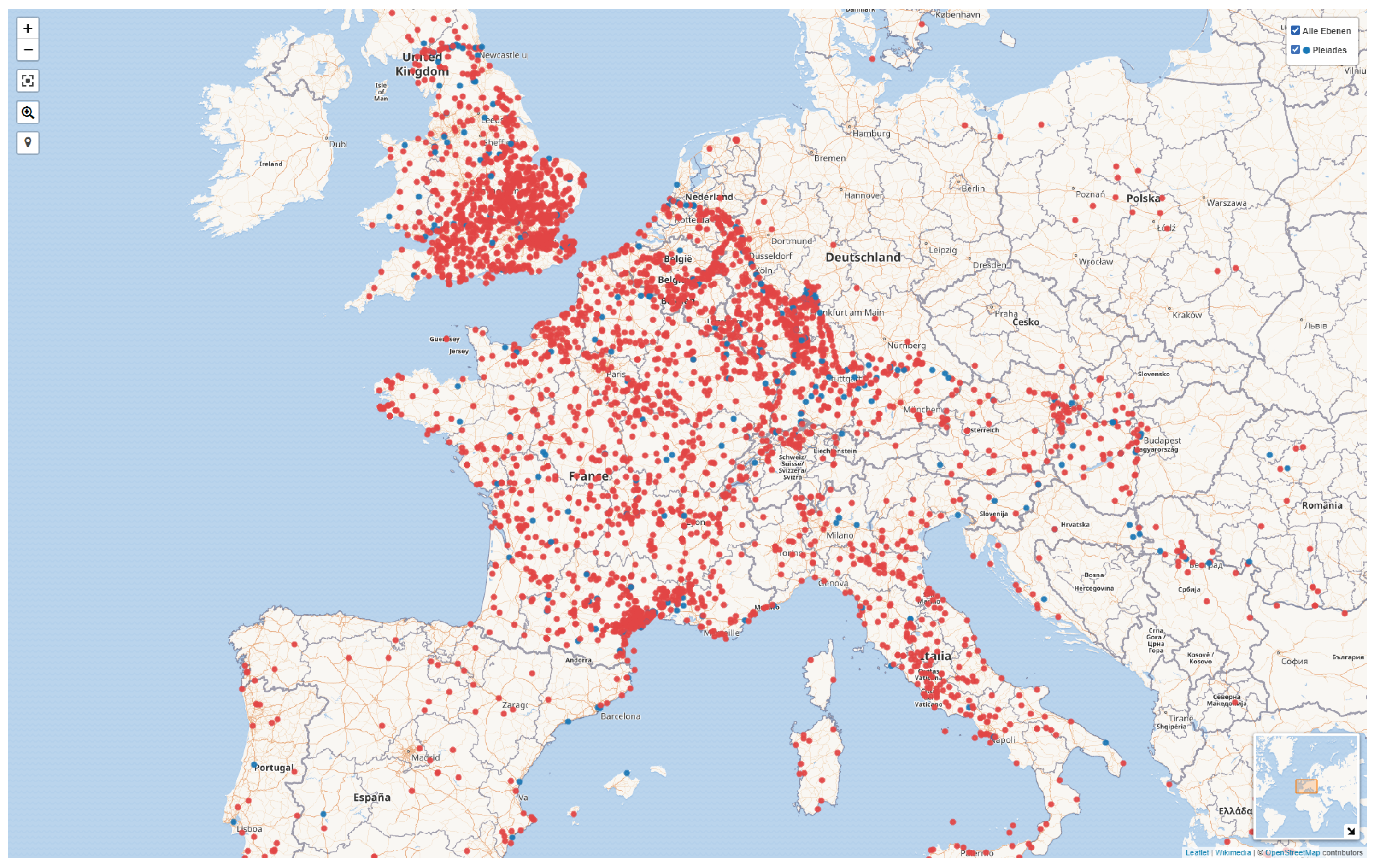
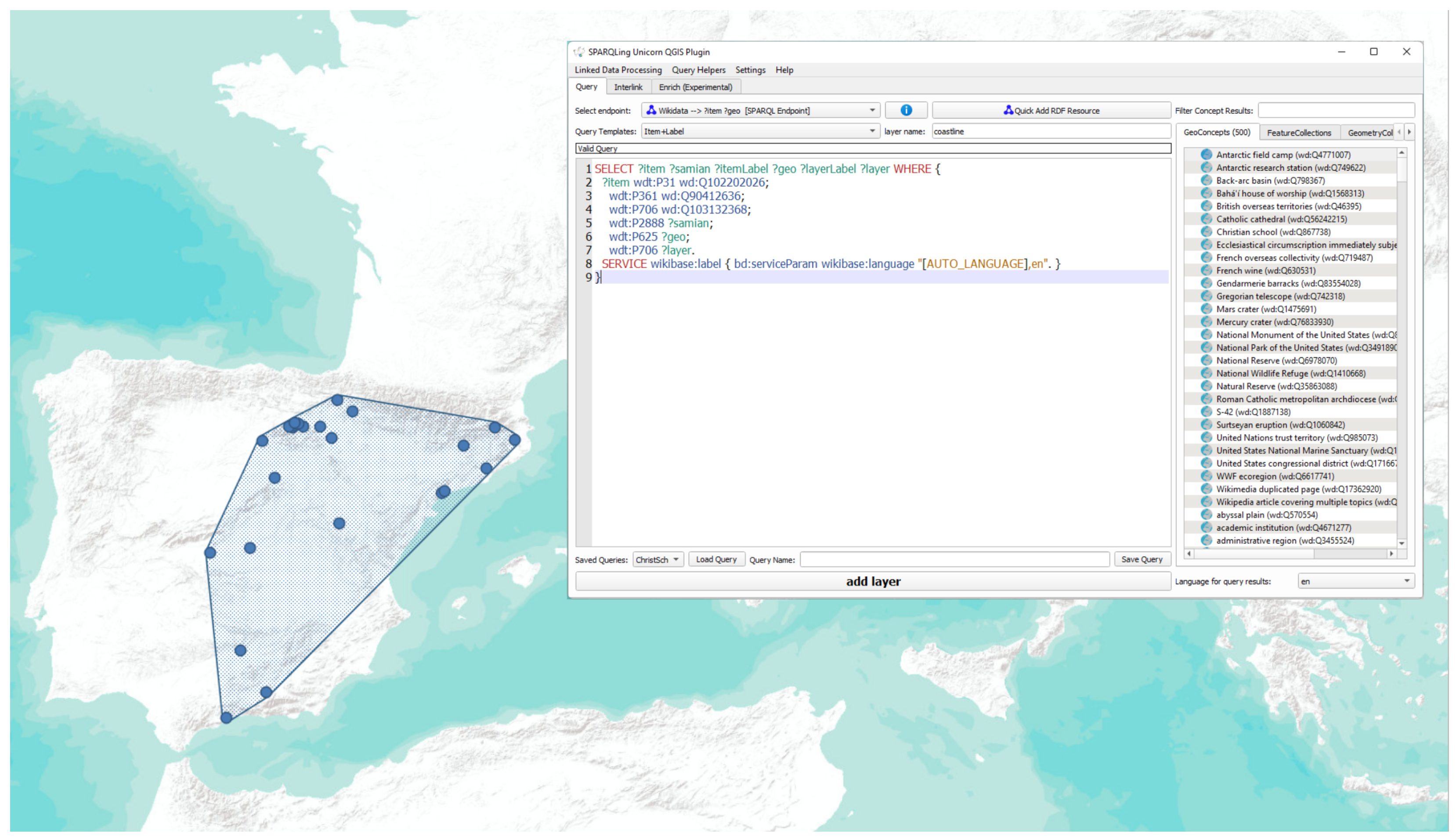
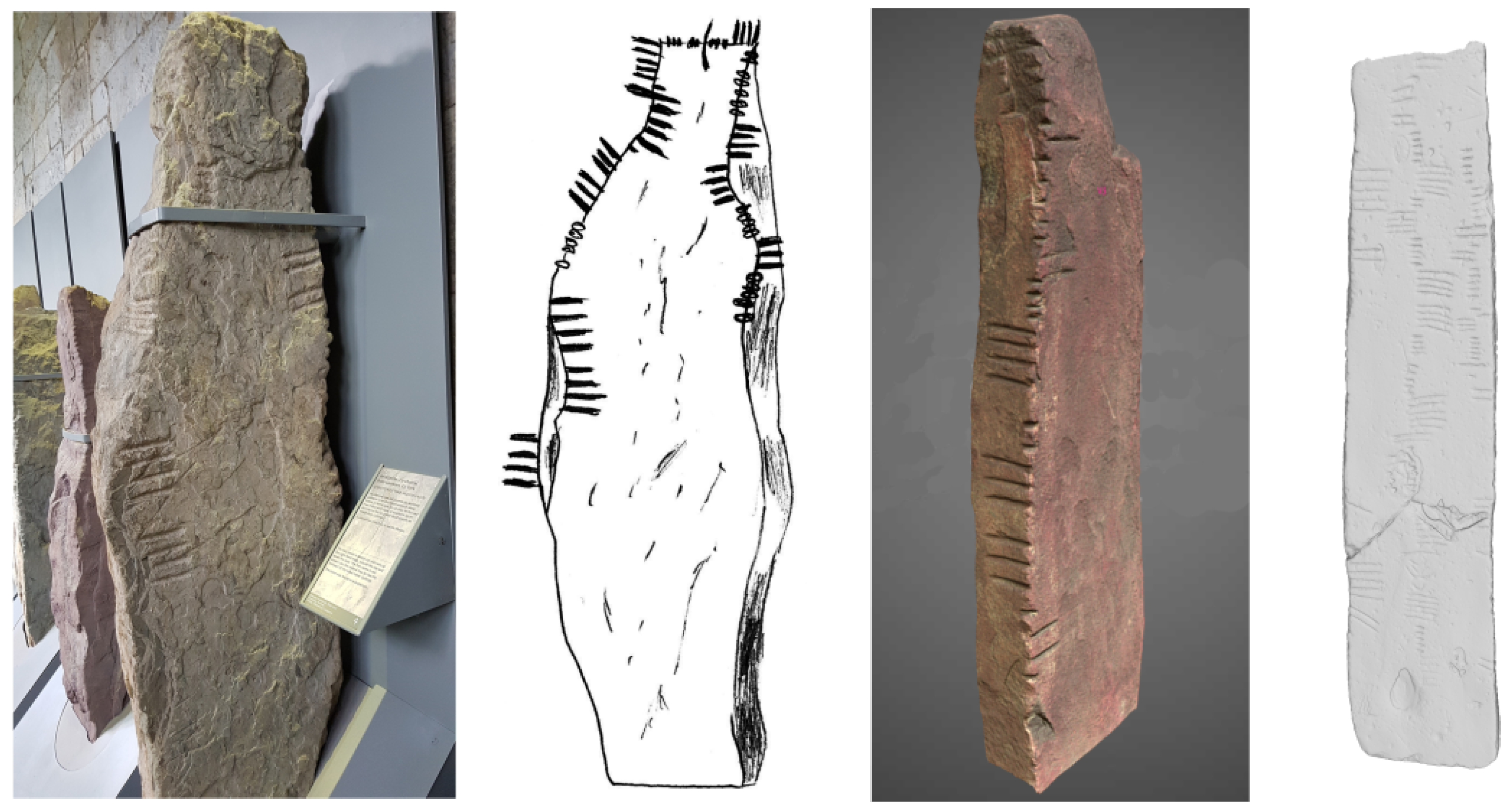
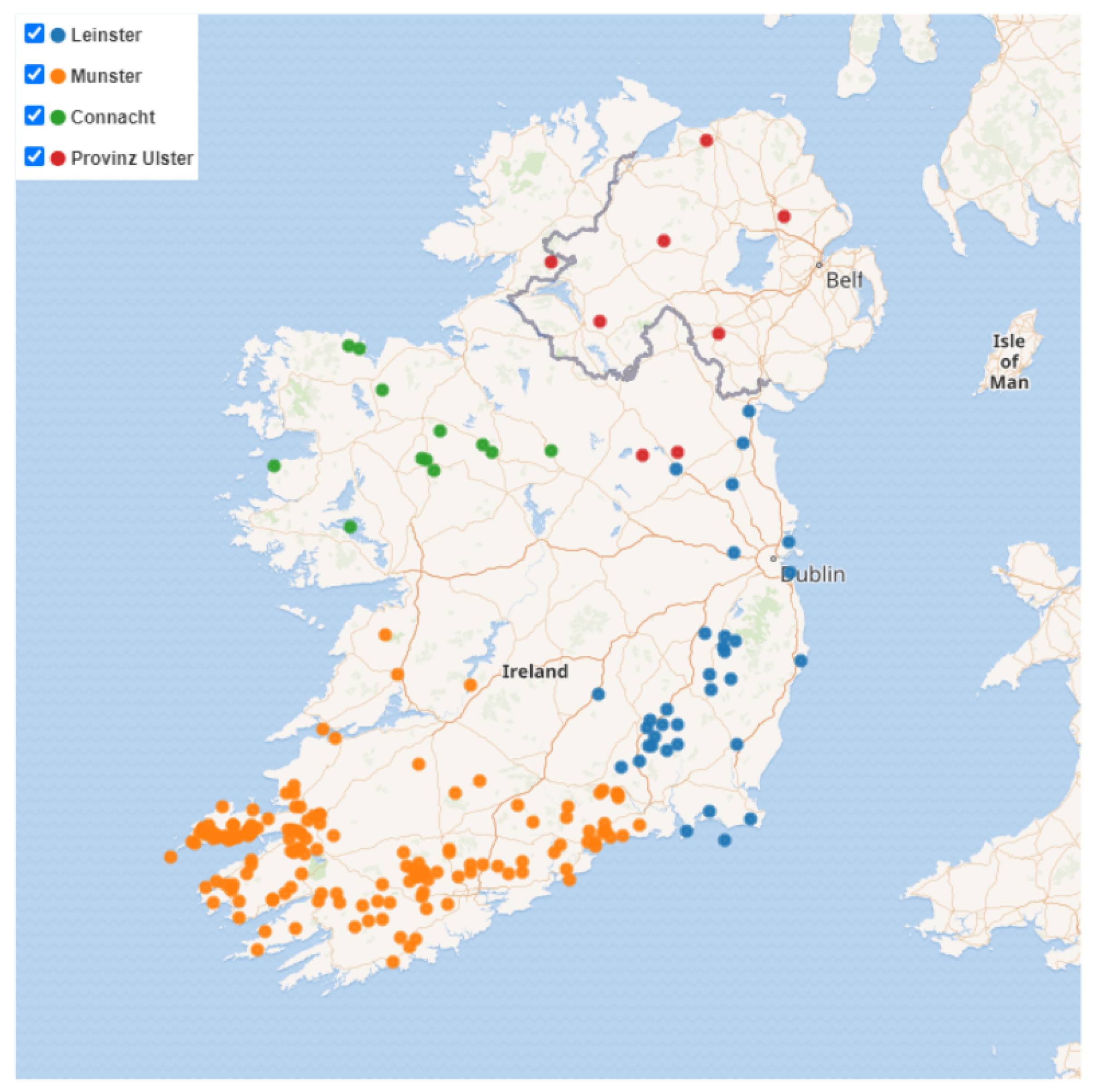
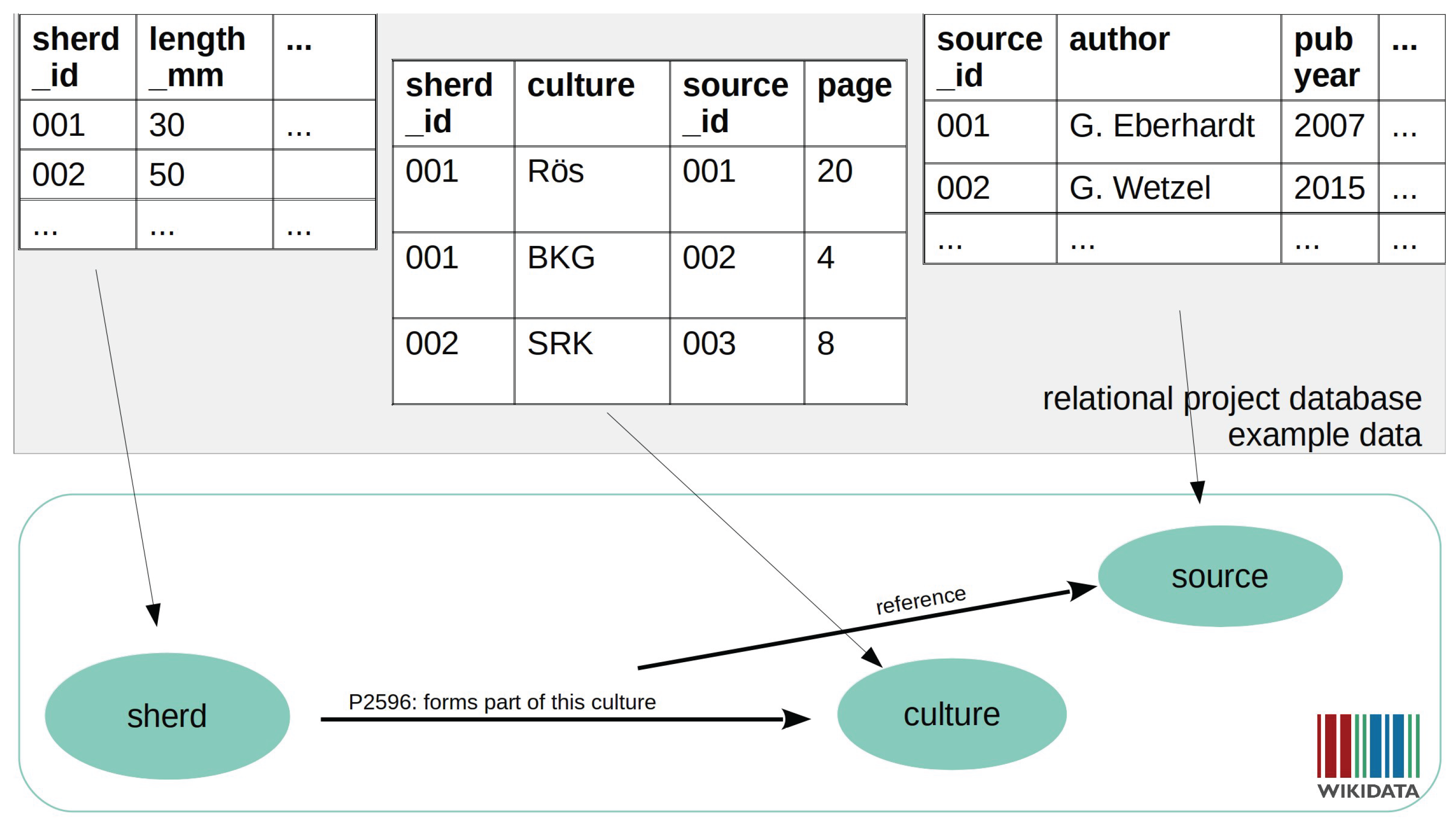
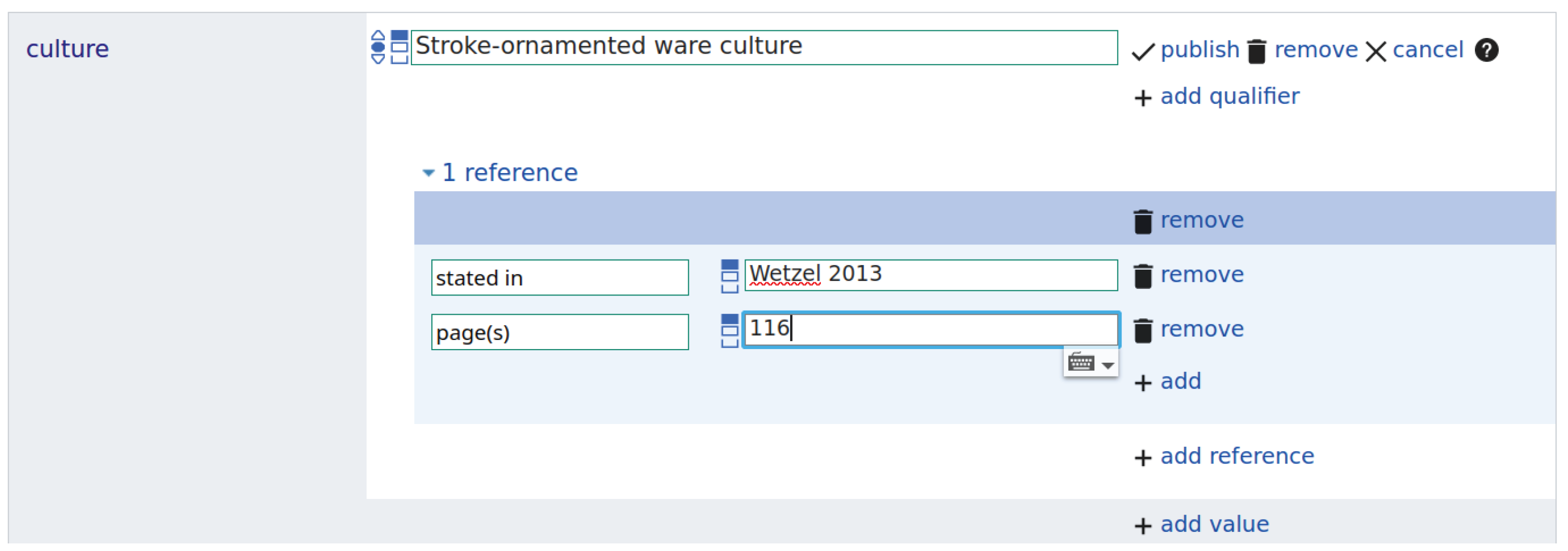
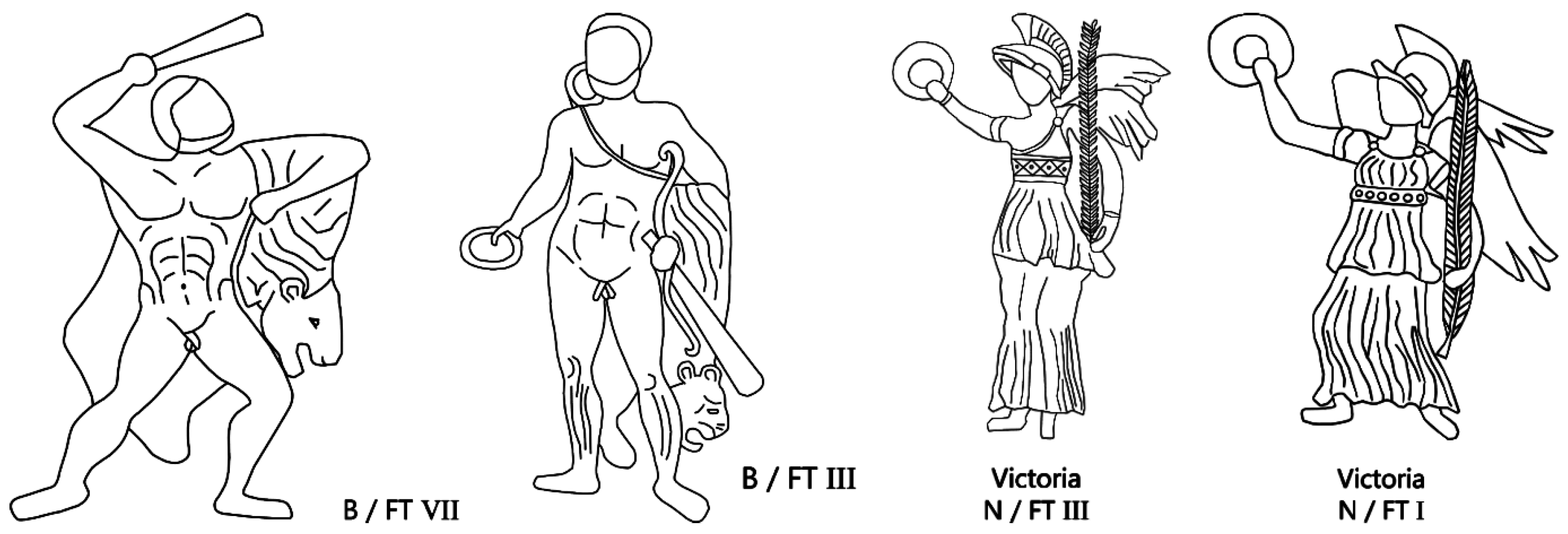
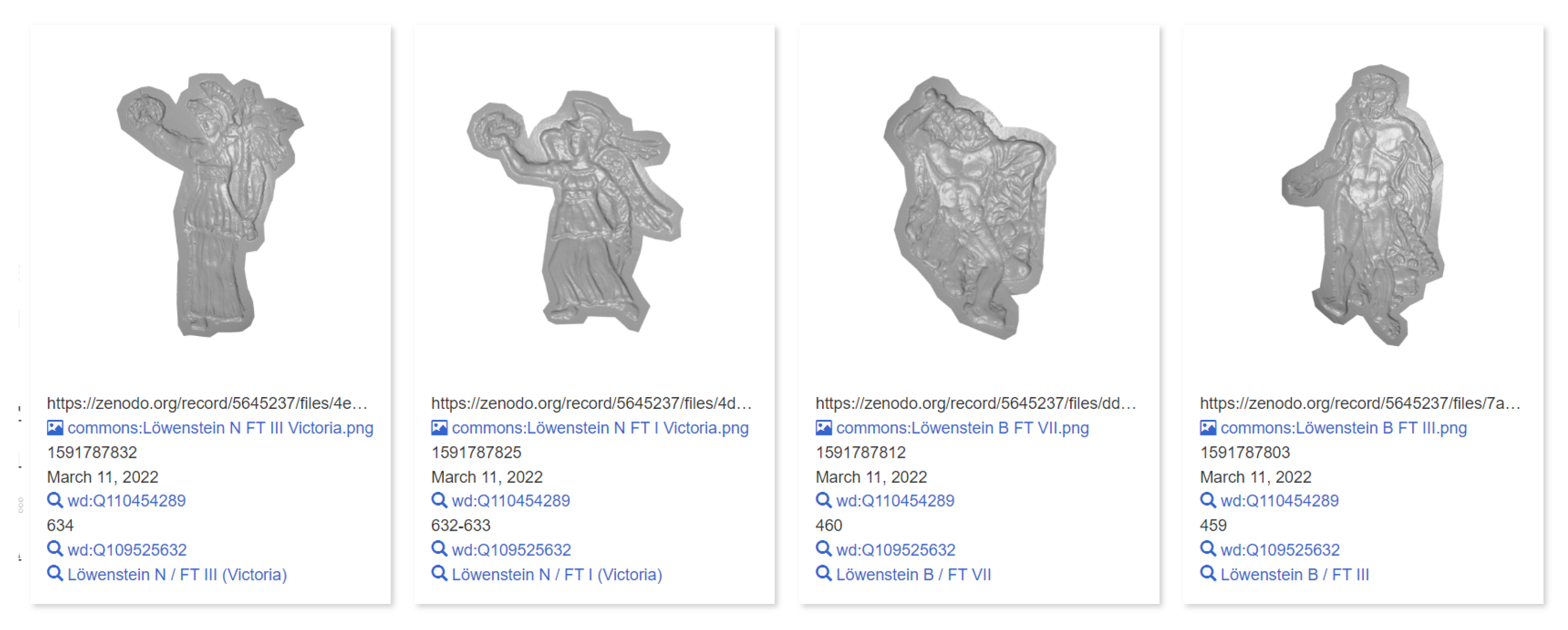

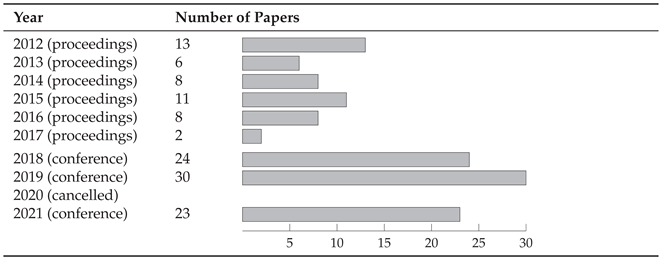 |
| Discovery Site | Production Centre | Kiln Region | |
|---|---|---|---|
| QID | Rheinzabern (Q103191516) | La Graufesenque (Q102763431) | South Gaulish Samian Ware Kilnregion (Q102764958) |
| instance of (P31) | Samian Ware Discovery Site (Q102202066) & archaeological site (Q839954) | Samian Ware Production centre (Q102202026) & archaeological site (Q839954) & manufactory (Q380342) | Samian Ware Kilnregion (Q102201947) & archaeological site (Q839954) & Economic region of production (Q5333539) |
| part of (P361) | Samian Research (Q90412636) | Samian Research (Q90412636) | Samian Research (Q90412636) |
| located in (P706) | n/a | South Gaulish (Samian Ware Kilnregion) (Q102764958) | n/a |
| coordinate (P625) | 49°7′5.016″ N, 8°16′41.016″ E | 44°6′0.000″ N, 3°4′59.999″ E | 44°4′44.666″ N, 2°36′8.561″ E |
| Geoshape (P3896) | n/a | n/a | SamianKilnregionSouthGaulish |
| exact match (P2888) | lado:samian/loc_ds_1004152 | lado:samian/loc_pc_2000001 | lado:samian/loc_kr_131462 |
| Pleiades ID (P1587) | 109362 | n/a | n/a |
| Cradle form | samian ware discovery site | samian ware productioncentre | samian ware kilnregion |
| SPARQL query | https://w.wiki/52Tu | https://w.wiki/4pKz | https://w.wiki/4pL4 |
| B / FT VII | B / FT III | N / FT III (Victoria) | N / FT I (Victoria) | |
|---|---|---|---|---|
| QID | Q110892406 | Q110892402 | Q110892417 | Q110892415 |
| instance of (P31) | iconographic item (Q109525730) & work of art (Q838948) | iconographic item (Q109525730) & work of art (Q838948) | iconographic item (Q109525730) & work of art (Q838948) | iconographic item (Q109525730) & work of art (Q838948) |
| part of (P361) | Löwenstein (2015) (Q109525632) & ARS3D project (Q105268778) | Löwenstein (2015) (Q109525632) & ARS3D project (Q105268778) | Löwenstein (2015) (Q109525632) & ARS3D project (Q105268778 | Löwenstein (2015) (Q109525632) & ARS3D project (Q105268778) |
| has creator (P170) | Sophie z. Löwenstein (Q110454289) | Sophie z. Löwenstein (Q110454289) | Sophie z. Löwenstein (Q110454289) | Sophie z. Löwenstein (Q110454289) |
| collection (P195) | Mythologische Darstellungen auf Gebrauchsgegenständen der Spätantike. Die appliken- und reliefverzierte Sigillata C3/C4 (Q109525632) [133] | Mythologische Darstellungen auf Gebrauchsgegenständen der Spätantike. Die appliken- und reliefverzierte Sigillata C3/C4 (Q109525632) [133] | Mythologische Darstellungen auf Gebrauchsgegenständen der Spätantike. Die appliken- und reliefverzierte Sigillata C3/C4 (Q109525632) [133] | Mythologische Darstellungen auf Gebrauchsgegenständen der Spätantike. Die appliken- und reliefverzierte Sigillata C3/C4 (Q109525632) [133] |
| depicts (P180) | Hercules (Q240679) | Hercules (Q240679) | Victoria (Q308902) | Victoria (Q308902) |
| same as (P460) | Armstrong 8.108 [134] (Q110892542) | Armstrong 8.109 [134] (Q110892540), Atlante 135 [135] (Q110892520) | Armstrong 8.100 [134] (Q110892537) | Armstrong 8.101-103 [134] (Q110892533; Q110892534; Q110892535) |
| image (P18) | Löwenstein B FT VII.png | Löwenstein B FT III.png | Löwenstein N FT III Victoria.png | Löwenstein N FT I Victoria.png |
| Property | Data Entry Options | Example: Q111600125 |
|---|---|---|
| instance of (P31) | mandatory: archaeological find (Q10855061) and pottery ware (Q17379525) | archaeological find (Q10855061) and pottery ware (Q17379525) |
| made from material (P186) | mandatory: ceramic (Q45621) | ceramic (Q45621) |
| instance of (P31) | drop-down-menu: rim sherd (Q106990428), wall sherd (Q106990472), base sherd (Q106990489), ... | wall sherd (Q106990472) |
| image (P18) | free field to link to Wikimedia file | SBK-Scherbe_Hohenbrück.jpg |
| has pattern (P5422) | drop-down-menu: incising (Q6014696), stamp (Q96093273), triangle (Q19821), line (Q1228250), quadrilateral (Q36810), ... | stamp (Q96093273) and quadrilateral (Q36810) |
| culture associated with item (P2596) | drop-down-menu: Linear Pottery Culture (Q806348), Stroke-ornamented Ware Culture (Q1932196), Rössen Culture (Q1886212), ... | Stroke-ornamented Ware Culture (Q1932196) |
| discoverer or inventor (P61) | free field to link to Wikidata item | |
| location of item at discovery (P189) | free field to link to Wikidata item | Hohenbrück (Q1623655) |
| time of discovery (P575) | free field to enter date | |
| part of WikiProject (P5008) | mandatory: Prehistoric Ceramics (Q107588426) | Prehistoric Ceramics (Q107588426) |
| stated in (P248) | drop-down-menu: volunteer (Q24716636), Heritage Management of Baden-Württemberg (Q1541782), Heritage Management of Bavaria (Q812412), ... all other German Heritage Management institutions | Heritage Management of Brandenburg (Q897952) |
| described by source (P1343) | free field to link to Wikidata item | |
| described by URL (P973) | free field to enter URL | https://brandenburgikon.net/index.php/de/sachlexikon/stichbandkeramik |
Publisher’s Note: MDPI stays neutral with regard to jurisdictional claims in published maps and institutional affiliations. |
© 2022 by the authors. Licensee MDPI, Basel, Switzerland. This article is an open access article distributed under the terms and conditions of the Creative Commons Attribution (CC BY) license (https://creativecommons.org/licenses/by/4.0/).
Share and Cite
Schmidt, S.C.; Thiery, F.; Trognitz, M. Practices of Linked Open Data in Archaeology and Their Realisation in Wikidata. Digital 2022, 2, 333-364. https://doi.org/10.3390/digital2030019
Schmidt SC, Thiery F, Trognitz M. Practices of Linked Open Data in Archaeology and Their Realisation in Wikidata. Digital. 2022; 2(3):333-364. https://doi.org/10.3390/digital2030019
Chicago/Turabian StyleSchmidt, Sophie C., Florian Thiery, and Martina Trognitz. 2022. "Practices of Linked Open Data in Archaeology and Their Realisation in Wikidata" Digital 2, no. 3: 333-364. https://doi.org/10.3390/digital2030019
APA StyleSchmidt, S. C., Thiery, F., & Trognitz, M. (2022). Practices of Linked Open Data in Archaeology and Their Realisation in Wikidata. Digital, 2(3), 333-364. https://doi.org/10.3390/digital2030019







